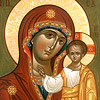History
Our Lady of Kazan is an icon of the Theotokos popular in Russia since the 16th century. A close-up variant of the Hodegetria (Directress) style, it is noted mainly for the Child standing, with the Virgin chest-length. The Kazan icons are traditionally small, following the original (9×11 inches). The Kazan icon of the Virgin remains popular, especially as a wedding gift, and is sometimes associated with Russian nationalism.
The image of Our Lady of Kazan is said to have come to Russia from Constantinople in the 13th century. After the Tatars besieged Kazan and made it the capital of their khanate in 1438, the icon disappeared, and it is not mentioned again until the 16th century, some years after the liberation of Kazan by Ivan the Terrible in 1552.
 Празднование в честь Казанской иконы Божией Матери
Празднование в честь Казанской иконы Божией Матери 